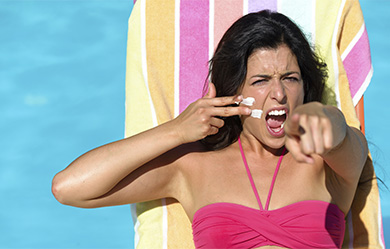
Australians are sturdy and lucky for that! Harsh climatic conditions are the theme of an Australian lifestyle. Our ongoing challenge with bush fires and floods show us how confronting the intensity of our environment continues to be.
One question I’m often asked reverts back to sunscreen. ‘Do Waterlily moisturisers include an SPF?’ To which comes my unforgiving reply, ‘No!’.
It may sound like an oxymoron, an Australian skincare company that is defiant against adding SPF to its formulations, but let me tell you why.
Just before I continue, let’s be very clear on what is required to enable the SPF rating in your stand-alone sunscreen.
Watch any dermatologist apply neat sunscreen to the face and you’ll soon learn it’s an intimidating amount of product. One full teaspoon is the actual amount required to receive the SPF protection.
Volume wise, that’s over 20 pumps of a Waterlily moisturiser! For me, putting sunscreen in a moisturiser is like going to dinner and mixing your entree with your dessert. It doesn’t really work (and no, there are no chocolate entrees!). Skincare and sunscreen serve distinctly different functions.
Each Waterlily product needs to be trans-dermal to penetrate through the skin to deliver nutrient to the basal layers.These deeper layers are where active skincare works to transform and regenerate the skin. Sunscreen however, is designed to sit ON the skin, offering protection by either physical (reflective) or chemical filters to prolong the skin from burning.
And this bit works: when applied correctly, chemical filters protect against UV-B light which prevents the skin from burning (the first sign of too much time in the sun). But here’s the kicker – they don’t appear to be as effective at blocking UV-A light. This means when exposed to sunlight for longer periods UV-A penetrates deeper, affecting melanocytes vulnerable to cancer.
Chemical sunscreens work by absorbing and dispersing radiation and free radicals into the skin causing possible inflammation. Oxidative stress from inflammation is one of the leading causes of the skin ageing prematurely.
Needless to say, I’m not fired up about using chemical sunscreens as a remedy for sun safety. So what’s the answer? What about this. Could we remember what our ancestors did and stay out of the sun during peak times of the day? It’s no accident that until 1950 melanoma was not that common. How about we bring back hats? Clothes that suit the sun? And what if we included more omegas and carotene’s in our diet to boost our skins immune function? And please don’t even start me on sunbaking!
If sun protection is required it needs to be a separate layer to our skincare. It’s also safer to use physical sun protection like zinc and other minerals which mechanically reflect the sun’s rays.
In my opinion, the best layer of chemical free sun-protection for the face comes from the mineral makeup ranges which are now in plentiful supply. These minerals, especially zinc oxide, offer up light-reflecting particles which combats UV-A, UV-B and UV-C light.
Beware though … just like skincare, not all mineral makeup is the same. Watch the label listing and avoid brands using talc or other irritants. Seek brands that use pharmacy-grade minerals only.
I love using and recommending Issada Cosmetics, a professional Australian brand that prides itself on the finest grade and quality of minerals.
These support a great skin care solution without compromising on pigment strength, longevity or finish. See for yourself: www.issadacosmetics.com
* Michelle Reeve is the founder and managing director of leading spa wellness brand Waterlily Australasia, a range encompassing over 150 professional skin, body and spa rituals. Michelle is an expert in a range of natural medicine modalities; however it is her extensive experience in aromatherapy that inspires and drives her passion to continue to deliver a true active aromaceutical spa wellness solution for spas around Australia.




